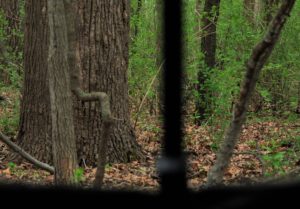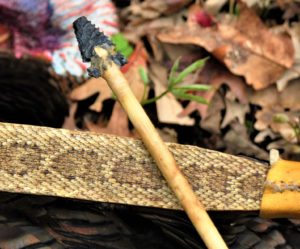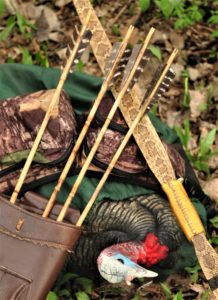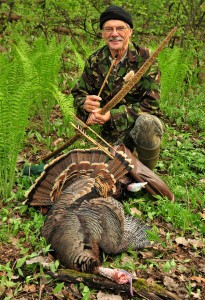Photography courtesy of Lowell Washburn, all rights reserved.
By now, it had become obvious that the gobbler was getting plenty cranked up. Couldn’t blame him. I was getting plenty revved myself. The turkey and I had been playing an ebb and flow, high stakes game of hide and seek for more than two hours now. Patience was growing thin on both sides.
From the turkey’s perspective, the hen he was hearing should be trotting to the sound of his gobbling. That’s how things are supposed to work. I, on the other hand, was trying my best to persuade the bird to come to me. It was a classic woodland standoff with the gobbler moving closer only to march away again. The scene had been repeated time and again. That was our game. And although I had yet to spot the turkey, I could easily track his whereabouts by the sound of his voice.
When bow hunting wild turkeys, I avoid open field edges whenever possible. Instead, I prefer to sit in the thickest, brushiest areas I can find. Today’s location readily fit that description. Sitting in a tiny opening smack in the middle of the timber, I was completely surrounded by the stately gray trunks of century-old oak trees and, at the lower level, a near impenetrable tangle of leafed out gooseberry.
I like these kinds of areas for two reasons. First of all, such habitats are absolute songbird magnets where warblers, thrushes, and a myriad of other species keep me entertained while matching wits with uncooperative turkeys — like the bird I was fooling with now. Secondly, turkeys feel secure in thick cover; it’s where they live. If and when a bird does come into the set, the encounter quickly becomes up close and personal. The in-your-face level of excitement can escalate to beyond belief.
Although the gobbler currently in question was sounding off from a distance I estimated to be less than thirty yards, I still could not manage to spot the bird. Nevertheless, my optimism continued to soar. Ever since our encounter began, the turkey had been more or less indifferent to my prolonged pleadings. But things had recently taken a turn for the better. Now, every single time I made a call, the gobbler would respond by cutting me off before I could hit the second or third note. His armor was cracking.
My theory was confirmed when I suddenly spotted an object closely resembling the shape and color of a snowball moving through the dense greenery. It was the gobbler’s head, cautiously approaching my position. The gobbles had now become so loud that they seemed to shake the gooseberries. At 20 yards, the magnificent bird finally came into full view. Emerging from the emerald foliage in full strut, he was a sight to behold. With tail fanned, wings dragging, and head and neck tucked; the bird was displaying no lack of attitude as he made a stiff legged advance toward my plastic jake. The turkey had quit gobbling now; the bird’s only sound was created from the friction of his extended wing tips raking the forest floor. By the time the bird had approached to a distance of around five paces, he seemed larger than life – looming so close that you could almost smell the acorns on his breath. I had been taking photos as the turkey approached, but time had arrived to lay down the camera and pick up the bow.
One of the things I love about traditional archery is that most of the equipment is still handmade. Although I can’t make much of anything for myself, I’ve been blessed by friends who can. The 50 # bow I’m shooting is a good example. It was fashioned from a gnarly stave of Osage orange by outdoor survival instructor, real deal traditional archery enthusiast, and Lake Mills Police Chief, Dave Thomas. True to the design and traditions of the Native American flat bow, the weapon’s already sturdy limbs are further strengthened by a layer of natural sinew hammered from the tendons of a white-tailed deer. As a finishing touch, the sinew backing was covered by a matched set of diamondback rattlesnake hides after the snakeskins’ original owners became the main entrée at a south Texas BBQ. Although the wooden bow has been around for the better part of a quarter century, it still sends an arrow straight to the mark. Missed shots can be chalked up to human, rather than equipment, error.
My arrow was also a handcrafted work of art. Its 70-grain, needle pointed broadhead was hewn from a chunk of jet black obsidian and then chipped to razor sharp perfection by renowned flint knapper and primitive archer, Ryan Gill. A nationally acclaimed authority on primitive archery, Ryan is the last word in making and using stone tools and weapons. You can check out his primitive archery website and videos at gillsprimitivearchery,com
The primitive arrow was completed by hafting the volcanic glass broadhead to a shaft of Florida river cane – a little known species of North American bamboo. In spite of the fact that an obsidian edge can literally be sharper than surgical steel, it is also more fragile and prone to damage than flintstone. Although I used one of Gill’s flint tipped arrows to bag an 18-pound Iowa jake last week; I had never hunted with obsidian and was anxious to try. Today, it appeared as if my chance had arrived.
By the time I had picked up the bow and knocked the arrow, the strutting turkey had continued past and was now standing at around 7 or 8 paces facing the decoy – and me – directly head on. Although I prefer broadside shots at strutting birds, the head on stance looked pretty good too. Drawing the bow, I moved straight to the gobbler’s head, and released the arrow. There was a resounding ‘thunk’ as the broadhead struck home, hitting just past center on the bird’s crown. Unfortunately, the force was enough to fracture my beautiful obsidian tip. On a more positive note, the impact was also enough to completely derail the gobbler’s train of thought, causing the turkey to collapse on the spot.
After attaching my state tag to the turkey’s leg, I remained in that beautiful clearing for another half hour. Replaying the scene over and over in my mind, the hunt seemed too good to be real. As I continued to admire the slain gobbler, I detected a single faint gobble from the far end of the timber. But although I won’t be shooting any more arrows at Iowa turkeys this spring, the sound did provide a vivid reminder that the hunt had not ended. Iowa’s photography season never closes, and there are still plenty of spring gobblers who need their portraits taken. It’s as good an excuse as any for getting off the couch and into the great out-of-doors.






 Tom Cope
Tom Cope Sue Wilkinson
Sue Wilkinson Susan Judkins Josten
Susan Judkins Josten Rudi Roeslein
Rudi Roeslein Elyssa McFarland
Elyssa McFarland Mark Langgin
Mark Langgin Adam Janke
Adam Janke Joe Henry
Joe Henry Kristin Ashenbrenner
Kristin Ashenbrenner Joe Wilkinson
Joe Wilkinson Dr. Tammy Mildenstein
Dr. Tammy Mildenstein Sean McMahon
Sean McMahon